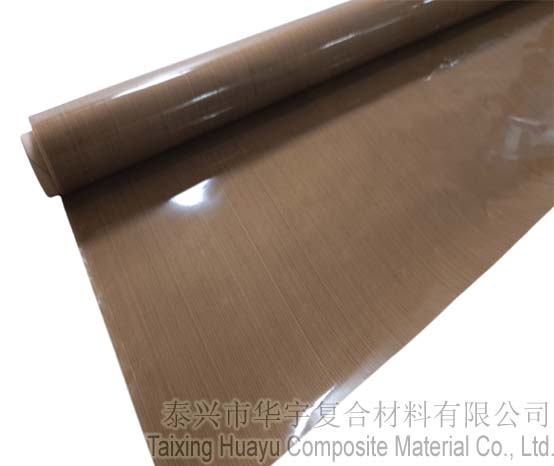
In the arena of precision manufacturing, a seemingly ordinary double-sided high-temperature PTFE Coated Fiberglass Fabric is quietly rewriting the rules of cutting technology. One side is coated with soft silicone, the other side is coated with smooth PTFE resin. These two contrasting materials work together under high temperatures to perfectly combine the seemingly contradictory properties of "anti-slip" and "non-stick." This innovation in materials science is quietly revolutionizing hot-cutting machines, high-frequency heat sealing, and even food packaging.

1. The Philosophy of Symbiosis of Contradictory Materials: From Conflict to Collaboration
Silicone and PTFE, the "ice and fire" of the material world, are traditionally considered incompatible. Silicone, known for its high viscosity, remains stable in extreme temperatures ranging from -60°C to 250°C; PTFE, renowned for its ultra-low coefficient of friction, resists corrosion from strong acids and alkalis. When these two materials are combined through a special process, a revolutionary solution is born: the silicone surface acts as a "fixator," wrapping irregular materials with its soft elasticity; the PTFE surface acts as an "isolator," allowing the cutting tool to move smoothly.
This contradictory unity creates a remarkable synergistic effect in the working environment of the hot cutting machine. When cutting synthetic fibers, the silicone surface firmly "attaches" the fabric to the work surface, preventing shrinkage caused by the high temperature melting; the PTFE surface ensures that the molten fiber does not adhere to the blade, maintaining a sharp and clean cut edge. This dual "fixation-isolator" mechanism eliminates the material shifting and sticking problems common in traditional cutting processes.
II. The Invisible Guardian of High-Frequency Heat Sealing: From Tool to Process Innovation
In the field of high-frequency heat sealing, this double-sided fabric plays an even more critical role. When the electrode applies pressure to the material, the silicone surface acts as a buffer layer, not only evenly distributing the pressure but also compensating for minor surface irregularities through its own elasticity, ensuring a complete heat seal line. At the same time, the PTFE surface acts as an invisible barrier, isolating the electrodes from the mold, preventing oxidation and adhesion of metal parts caused by high temperatures.
The case of an automotive interior manufacturer is quite representative. Before the introduction of this double-sided fabric, mold changes during the high-frequency heat-sealing process were as frequent as three times a week, and the defect rate due to material adhesion exceeded 15%. After adopting the new high-temperature fabric, mold life was extended to three months, and the defect rate plummeted to below 2%. More importantly, operators no longer need to stop the machine frequently to clean the mold, resulting in a 40% increase in production efficiency. This silent process revolution is quietly reshaping the cost structure of the manufacturing industry.
III. The Last Line of Defense for Food Safety: A Leap from Industry to Consumer Goods
When this double-sided fabric enters the food packaging industry, its significance goes beyond simple process improvements. FDA-compliant silicone-PTFE composite materials are building an invisible barrier to food safety. When heat-sealing food packaging at high temperatures, the silicone surface ensures precise positioning of the packaging film, preventing slippage and leaks. The PTFE surface prevents melted packaging material from adhering to the heat-sealing blade, eliminating the risk of microbial contamination from residual material.
The practice of a dairy company offers valuable insights. Using traditional heat-sealing processes, leakage rates due to film shifting were as high as 5%, resulting in product waste and numerous consumer complaints. After switching to double-sided high-temperature cloth, the leakage rate dropped to below 0.3%, enabling the company to pass more stringent food safety certifications and leading to a 30% year-on-year increase in product exports. This seemingly ordinary piece of high-temperature cloth is becoming an "invisible passport" for food companies to expand into international markets.
IV. The Future of Materials Science: Evolution from Tool to Ecosystem
From a materials science perspective, the emergence of this double-sided composite cloth is no accident. As manufacturing demands for precision, efficiency, and safety approach physical limits, the performance of a single material can no longer meet the demands of complex working conditions. The combination of silicone and PTFE heralds the evolution of material design from "single-function optimization" to "system-performance synergy."
In the future, similar composite materials may expand into even more fields: in 3D printing, composite platforms with one side adsorbing substrates and the other non-sticking can improve printing precision; in the biomedical field, coatings with one side being cell-friendly and the other anti-fouling can optimize tissue engineering scaffolds.
From hot cutting machines to high-frequency heat sealing, from industrial manufacturing to food safety, the story of this double-sided high-temperature cloth is, at its core, a story of humanity's continuous challenge to the limits of materials. It reminds us that true innovation often arises at the intersection of contradictions. When two seemingly opposing properties are cleverly combined, it can be a game-changing moment. The next time you see a material that possesses both "adhesive" and "non-stick" properties, consider: How many other opposing properties are waiting to be redefined by wisdom?